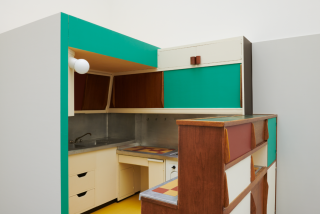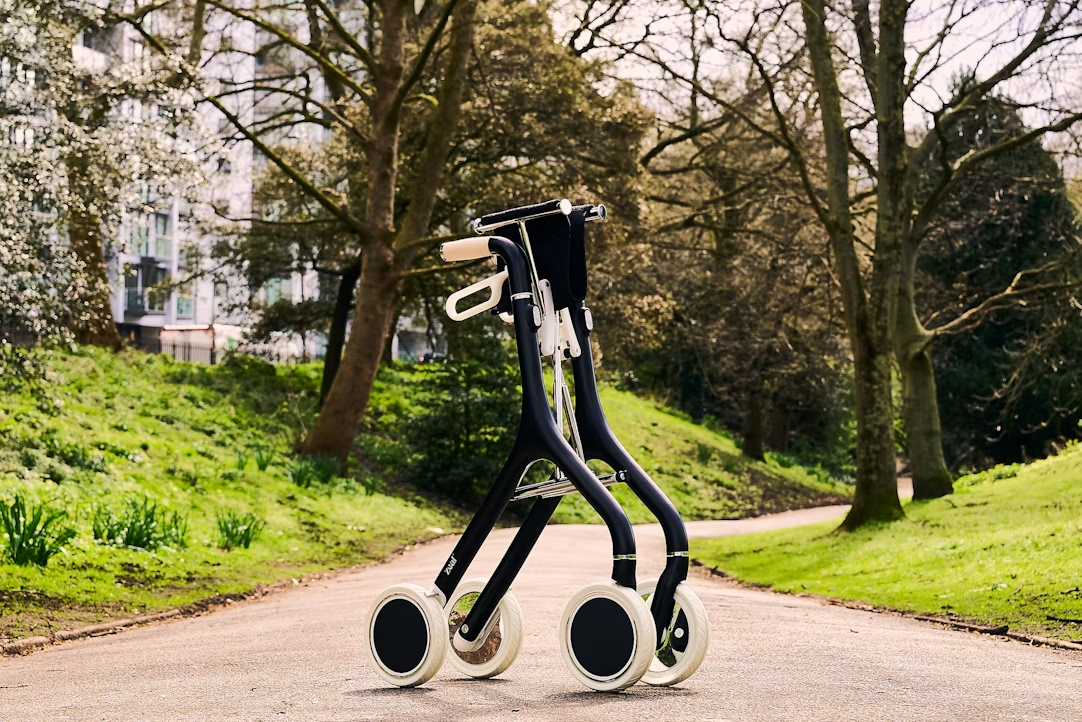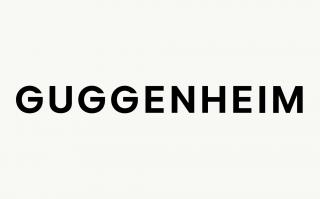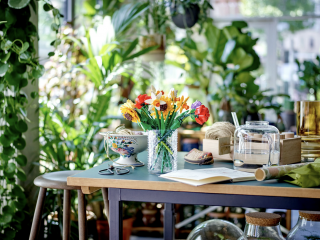Magazine
Design incorporates objects, people,
ideas based on the small pleasures of everyday life.
Meet your Beautiful design world with the DDP Design Fair.
-

You Can Now Wear Apple’s Running Shoe Emoji Courtesy of Jose Wong
Emoji Comes True: Apple's Running Shoes Are Now Available In The Real WorldApple users will no longer have to zoom in on their computer monitors or smart device screens to get a closer look at Apple's sneaker emoji, which is smaller than their pinky nails. If you want, you can even buy a physical pair of sneakers to display, admire, and wear every day.Jose Wong, a Japanese parody designer, artist, actor, photographer, and all-around creative, has taken the running shoes emoji from the Emoji list in Apple computers and iPhones and turned it into a real sneaker, which is now available on his e-commerce site ABCD.The sneaker, named “Shoe 1,” closely replicates the shape and color of the Apple “running shoe” emoji. Apple's sneaker emoji is very similar to the 1988 New Balance 574 model, which Steve Jobs enjoyed wearing. For reference, the legendary former Apple founder and CEO Steve Jobs was a fan of the brand's 991 and 992 models.Even though the shoe comes from a digital icon, it is made to be functional as a sneaker.The upper is wrapped in mesh and full-grain nubuck leather, and the outsole is made of rubber with 5% recycled plastic. It is stretchy and comfortable for everyday wear. The midsole and heel are cushioned with lightweight foam rubber to protect the foot and ankle while jogging or running. The upper is finished with white laces, and the design is faithful to the Apple emoji.Another hidden feature of the Apple Running Shoes Emoji sneakers that will excite Apple fans who take a keen interest in Apple devices is the fact that the shoe can be disassembled to reveal Apple's A5 processor inside the sole. Of course, it's not a real A5 chip, but a printed image of the chip's shape, but it gives the wearer the pleasant imagination that every step they take while running in the shoes is powered by a powerful Apple A5 processor.The shoes will be available in unisex US sizes 5 through 12, and once an order is placed, there are no returns or exchanges for products shipped.For Jose Wong, a pair of Apple sneakers is nothing without matching Apple accessories. Therefore, each pair of Apple Emoji Running Shoes ordered is designed to arrive in a “crazy big box that comes with everything." The crazy big box includes socks, a hat, and additional Apple emoji prints.
2024-12-01105 -

The Upcoming Centennial of Kitchen Design: Reflecting on the Function and Meaning of the Kitchen
A Chronological Overview of Built-in Kitchen Design, Curated by the Pinakothek der Moderne in Munich, GermanyToday, the significant reduction in the amount of time women spend on household labor, particularly in the kitchen—such as food preparation, ingredient management, cooking, dishwashing, and cleaning—has been greatly facilitated by the work of modernist architects and designers a century ago. These innovations have even contributed to freeing women from kitchen labor and integrating them into the broader social sphere.Over the past 100 years, modern architects and designers have drastically reduced the amount of time women spend on endless household labor, particularly in the kitchen. Tasks like food preparation, storage, cooking, dishwashing, and cleaning have become more efficient, allowing women to move beyond kitchen labor and integrate fully into the social sphere.An exhibition titled Kitchen Culture: ‘From the First Fitted Kitchen to the Individually Configured Kitchen’ is currently on display at the Pinakothek der Moderne in Munich, Germany, celebrating the historical milestone of the birth of the modern built-in kitchen, a concept that has now been in existence for nearly 100 years. The exhibition, which opened on November 26, 2024, highlights this significant milestone in kitchen design history.Margarete Schütte-Lihotzky, the designer of the Frankfurt Kitchen (Frankfurt Küche), which became a symbol of modern kitchen design, created the first built-in kitchen in 1926. Schütte-Lihotzky designed the kitchen as a model for the 10,000-unit working-class apartment complex in Frankfurt. The kitchen, intended for the modern woman balancing work and family life, was designed considering the average height and build of German women at the time. It efficiently accommodated all domestic tasks, including food preparation, storage, dishwashing, and ironing, within a compact two-square-meter space, becoming a paragon of scientific spatial planning. After World War II, European architects, inspired by Schütte-Lihotzky’s design, introduced functional kitchen designs throughout Europe. These kitchens transformed what had once been chaotic spaces filled with smoke and clutter into clean, organized storage areas that also served as communication hubs for the family.For instance, Le Corbusier, Charlotte Perriand, and André Wogenscky, who worked on the interior design of the Unité d’Habitation residential complex in Marseille (1946-52), also designed functional built-in kitchens.Later, Danish modernist designer Arne Jacobsen introduced built-in kitchens as part of his interior design for a bungalow at the Berlin International Building Exhibition in 1957. This led to the development of the modular kitchen design series “Eschenbach K 21” by VEB Küchenmöbel Radeberg, which became the standard for kitchens in Eastern Europe, the Soviet Union, and Western Europe during the Cold War.In the latter half of the 20th century, with the shift to post-industrial economic systems and postmodern trends, the concept of the kitchen underwent another significant transformation. Driven by feminism, the rising socio-economic status of women, and a consumerist culture that turned everything into a commodity—including cooking, the kitchen evolved from a space for physical labor into a social space for interaction. It became a place where families and guests could gather, share food, and engage in conversation. This shift is clearly reflected in designs like Stefan Wewerka’s Küchenbaum (Kitchen Tree) (1984) and the Coffee Tree (1984) by the Kunstflug design group.Entering the 21st century, the built-in kitchen evolved into a high-tech, automated space that makes eating and drinking even more convenient. The Erlkönig island kitchen, designed by J. Gast, reinterprets the workbench and cooking island concepts introduced by Herbert H. Schueltes 40 years earlier, adapting them to fit the modern space culture.Today, kitchen design companies like OHA in Germany offer functional tools and equipment that assist with both the mental and physical aspects of cooking. While the kitchen still serves as a private, multi-purpose space for family and friends to gather, work, and relax, cooking as a labor has shifted to professional chefs in the foodservice industry, which has become a key part of global consumer culture. With dining out and take-out becoming widespread in the 21st century, kitchen design is evolving into a high-tech, almost sterile space, resembling a laboratory or semiconductor production line focused on cleanliness and precision. Source: Pinakothek der Moderne, Munich, Germany
2024-12-0183 -

Now It's the Era of Design for Elderly Mobility Aids
Inclusive Design to Improve the Quality of Life for Elderly Patients and Their Caregivers As aging populations continue to grow around the world, elderly health and care have emerged as critical social issues. This has highlighted the growing need for inclusive design to improve the quality of life for elderly patients and their caregivers. Ex-Seymour Powell industrial designer Josh King and his co-founder Georgia Williams, formerly a retail designer at Dior, have launched the Zeal Lifestyle Walker, an adult mobility aid.Traditionally, walkers, often referred to as "elderly walkers," were seen as assistive devices for seniors who struggle to walk independently in the later stages of life. However, King declares that the Zeal Lifestyle Walker aims to position itself as a luxury consumer goods experience.According to research by the National Institute of Health and Care Research, up to 70% of people abandon their assistive technologies, including mobility aids, due to unappealing design.The two designers analyze this design flaw as stemming from a lack of attention and affection for users of healthcare devices, as well as a lack of will to create better designs. After four years of closely observing elder users’ walking behaviors and improving the product’s user experience, they introduced the Zeal Lifestyle Walker.The Zeal Lifestyle Walker is designed with two main elements, taking into account the elderly's physical conditions and the human life cycle. As the name "Zeal" suggests, the walker promises to be a passionate companion for elderly patients.Firstly, it enhances the mobility of elderly patients in hospitals or nursing homes, as well as improving their overall quality of life. The Zeal Lifestyle Walker supports patients in standing up and walking safely and comfortably, without the bulky or obtrusive medical devices found in traditional walkers.For instance, the walker features shock-absorbing wheels to ensure a smoother ride when the user is operating it, and the brake cables are positioned on the outside of the wheels to avoid entangling with the user's arms or legs. Additionally, the design makes it easy for caregivers to purchase parts and replace them independently when needed.Secondly, it improves the physical and mental satisfaction of elderly patients in the final stages of life, promoting longevity. The Zeal Lifestyle Walker differentiates itself from traditional products through its aesthetic beauty, aiming to pursue well-being.Aesthetically, existing walkers tend to be clinical grey or racing red, with black wheels and handle grips. Zeal comes in five pastel colours, and customers can customise the colour of certain elements, like the wheel caps and seats. Weighing just 5.9kg, it is lighter than most walkers on the market. Its sleek, modern design evokes the feeling of a contemporary chair, which can uplift both the user and the onlooker.The Zeal Lifestyle Walker, which is visually appealing and highly functional, can serve as a great example of how design interventions can help people of all ages who need mobility aids to overcome social stigmas associated with assistive devices and enjoy greater physical freedom. The product is priced between £80 and £1,200 depending on options, with discounts available for people with disabilities.Article source: Design Week. Image source: The Zeal Lifestyle Walker
2024-12-0167 -

Johnnie Walker Unveils World's Lightest Whisky Glass Bottle
Marketing Strategy Driven by ESG Principles and Environmental CommitmentJohnnie Walker, the iconic brand in the whiskey market, has replaced its traditional glass bottle with an innovative design that is 80% lighter than the usual packaging. Breaking away from the long-standing tradition of storing premium whiskey in heavy crystal decanters, Diageo, the parent company of Johnnie Walker, introduces this revolutionary packaging design as part of its marketing strategy. Through this move, Diageo aims to raise awareness on the importance of achieving net zero emissions and take a leading role in the global premium spirits industry, aligning with its ESG principles and environmental commitment.Diageo plans to produce 888 bottles of limited edition Johnnie Walker Blue Label Ultra, packaged in the world’s lightest glass bottles, and sell them at a retail price of $1,250 each. While limited-edition luxury product releases are a common marketing practice, Diageo aims to highlight the technological innovation and environmental benefits of the ultra-lightweight bottle design. The company also intends to expand the use of this packaging to standard Johnnie Walker labels, further promoting sustainability.Once the whiskey is removed, the empty glass bottles are remarkably light. Unlike the traditionally heavy and thick whiskey bottles that convey a sense of luxury, the new lightweight design feels more like holding a wine glass, which helps reduce carbon emissions in the process. Additionally, the ultra-lightweight bottles feature rounded, egg-shaped bottoms and are designed to be sold with protective stands.The Johnnie Walker Blue Label bottle features an innovative glass container weighing just 180 grams and holding 70 centiliters of liquid. The design was created by Şişecam based in Turkey, one of the top five glass manufacturers in the world. Each bottle is made using a traditional hand-blown technique by skilled artisans.This lightweight glass reduces carbon emissions by 0.5 grams for every gram of glass produced, and it is expected to significantly lower total carbon emissions during both the packaging and transportation processes.The UK government’s patent office has granted patents for four technologies used in the creation of the ultra-lightweight Johnnie Walker Blue Label bottle. However, Diageo has chosen to make the manufacturing licenses available royalty-free, allowing other liquor companies to adopt them. This move is expected to pave the way for a new packaging solution that may be adopted by competing brands in the future.Photo Source: Türkiye Şişe ve Cam Fabrikaları
2024-12-0164 -

Jessica Walsh Launches Her Own Type Foundry
Creating Typefaces That Blends Artistic Expression and Functional Design with 'Emotion' as a Creative CatalystJessica Walsh, a prominent figure in contemporary New York graphic design, has recently founded a new type foundry, Type of Feeling. She has declared her intention to take typography to the "next level" with groundbreaking and highly creative designs that are reshaping the graphic design world.As a graphic designer, Jessica Walsh’s passion for typography and her discerning eye for design are already well-established in the industry.Through years of providing branding design consultation for numerous companies and products, Jessica Walsh has reaffirmed that unique type design is a powerful design asset, contributing to strong brand language and storytelling. With this insight, she has launched Type of Feeling, a type foundry that combines artistic expression and functional design, alongside her design studio &Walsh.In today’s design industry, custom hand-crafted typefaces have become a specialized niche. Traditionally, graphic designers working at design agencies would either purchase fonts created by type designers or use mass-produced, commercially available fonts. However, the challenge of finding the best font to express the full visual concept of a project, especially in branding and product development, has led to a renewed focus on custom-made typefaces developed from the early stages of a project.Who would benefit the most from these custom-crafted typefaces? As implied by the agency's name, these fonts are particularly suited for smaller projects that establish an emotional connection with consumers through design elements—such as music or entertainment events, art exhibitions, or personal party invitations. They are also highly effective in branding work for businesses or organizations looking to communicate product identity and values.The inspiration behind all the typography designs created by Jessica Walsh’s Type of Feeling stems from the diverse and intricate emotions of human experience. For example, Walsh’s cherished ‘Jubel’ typeface captures the joy and exhilaration of celebration, while the ‘Ssonder’ typeface embodies the complexity of unique, individual life experiences. The ‘Onsra’ typeface visually represents the feeling of longing and unrequited love, much like the sensation of unrequited love.In the near future, custom typography design is expected to remain a specialized niche. Typography, in this regard, is a creative field that prioritizes visual meaning over profit. This indicates that typography design offers a blue ocean opportunity for creators aspiring to develop exceptional typefaces.Website: https://typeoffeeling.com/
2024-11-2981 -

From Hesitancy to Hope: How Freelancers Are Embracing AI
Designers view AI as a creative collaborator, keeping pace with the evolution of technologiesAccording to a recent article in the prestigious graphic design magazine PRINT, more and more freelance graphic designers are beginning to embrace artificial intelligence (AI) in their design process.Until recently, designers working in the creative sector have been resisting the mass deployment of generative AI technology, which began in earnest last fall, out of a vague fear and aversion to the idea that AI will take away creative jobs.However, a recent survey by German design agency platform '99 designs' found that across a wide range of creative businesses, from commercial logo design to extensive branding projects, freelance designers are becoming more open to AI as part of the creative process, suggesting that AI is becoming a working partner for creatives.In a survey of 10,000 freelance graphic designers in 135 countries around the world, more than half (52%) said they already use generative AI in their work. This means they are not just playing around with AI models, but applying them to real-world deliverables. Designers said that AI is particularly useful when brainstorming ideas, handling simple repetitive tasks, and streamlining graphic copying.AI-enabled work efficiency also helps reduce costs. Designers reported saving up to 45% on production costs compared to last year after using AI models. Therefore, for the time being, generative AI technology is seen as a tool that will bring new, creative inspiration at work as well as cost efficiencies in the creative sector.It is clear that AI is a disruptive innovation, one that will disrupt the job security of creative professionals and reshape the structure of the creative industry. However, it is encouraging to see that, in contrast to just a year ago, when designers were wary of AI as a disruptive and threatening competitor, this year, they see it as a creative collaborator, keeping pace with developments and advances in the technology and actively participating in its enhancement.Eighty percent of survey respondents believe AI will impact their future earnings, either positively or negatively. An overwhelming 88% say they need to learn new, innovative skills to stay competitive. A significant 33% of respondents are concerned about the possibility of losing income streams due to AI, while 47% expect AI to help them improve their income.*Source: PRINTArticle located at: https://www.printmag.com/ai/from-hesitancy-to-hope-how-freelancers-are-embracing-ai/*All infographics sourced from: /99 Designs/PRINT
2024-11-1875 -

Pentagram unveils a unified global identity for the Guggenheim
The work by Pentagram partner Harry Pearce aims to bring together four iconic locations with a fresh look that establishes Guggenheim as a leading global cultural brand.The Solomon R. Guggenheim Foundation, a beacon of modern and contemporary art since 1937, has launched a cohesive visual identity crafted by Pentagram partner Harry Pearce. The new brand system brings unity across the Guggenheim's four locations: New York, Venice, Bilbao, and the soon-to-open Abu Dhabi.From Frank Lloyd Wright's spiral marvel in New York to Frank Gehry's bold Bilbao structure, the Guggenheim museums are celebrated as much for their architecture as for their art. This legacy now extends to the museum's brand, which has evolved from the original 1982 identity by Massimo Vignelli and later versions by Abbot Miller in 2013. The new visual language, created by Pearce and his team in collaboration with Guggenheim's in-house experts and Jane Wentworth's strategy, centres on the ethos: 'One brand, one constellation, one vision, many experiences'.The new logo might seem simple, but it carries an air of authority. It nods to its heritage geometric typography and a unifying 'G' symbol that is abstract and modular. This symbol encapsulates the constellation of Guggenheim locations, their global spirit, and their shared vision. The symbol also draws on the museums' architectural forms, evoking their common geometric design while providing strong brand recognition across digital and physical spaces.Typography plays a major role, too. Guggenheim Sans, a refined adaptation of the Open Source font Inter by Rasmus Andersson, is joined by a sophisticated secondary font, Playfair. Additionally, the identity includes a bespoke Arabic version by Debakir and TB.D Studios, broadening its accessibility to the global audience, presumably in time for its grand opening in the Middle East. A complementary set of icons adds extra weight and relevance to the identity with bold geometric forms.Guided by the principle of 'Amplification', motion is integral to the identity's design, connecting Guggenheim animations to its brand mission: 'We amplify the power of many imaginations'. Animated iterations of the logo bring an expressive edge that helps liven the identity across many channels.Looking at the colour palette and various layout systems, it's clear that Pearce and his team wanted the art to speak for itself. Every visual seems to prioritise the artists Guggenheim welcomes through its doors. There is nothing overwhelming about Pentagram's design. But as any talented designer will admit, crafting something "simple" that doesn't take centre stage is quite the challenge. As Pearce explains, "Following museum guidelines, artist imagery is never cropped without consent, and graphics and typography are always kept separate and never overlaid onto the artworks."It's a modern yet accessible design that not only pays homage to the Guggenheim's heritage but also aims to position it as a museum for everyone. And by visually linking each museum's architecture with a contemporary digital presence, Pearce's new identity celebrates the Guggenheim as 'a museum for the world'.*News source: Creative Boom
2024-11-1886 -

LEGO Suggests 2025 is the Year of Indoor Plants and Flower Arrangements
LEGO Botanicals Debut Four New Flora SetsThe Danish toy maker LEGO is launching a special botanical set for 2025 to celebrate the upcoming New Year.This is not the first time LEGO has introduced products inspired by plants and flora. The company first launched The LEGO® Botanical Collection series in 2021, introducing LEGO bouquets and bonsai pots, and has since released new products to coincide with holidays such as Valentine's Day, Mother's Day and Christmas, when flowers are a popular gift.The four LEGO Botanicals sets, which will officially launch on New Year's Day, January 1, 2025, at toy retailers and online stores worldwide, bring the phytotherapeutic benefits of realistic plants and floral arrangements to modern homes.The first in the series is LEGO Botanicals Pretty Pink Flower Bouquet ($59.99 USD), which comes in a box with 15 flower stems with different species of flowers and leaves in different shapes. Consumers can attach, detach, and adjust the prefabricated plastic flowers and leaves as desired to create a unique bouquet.At a lower price point ($29.99 retail), the LEGO Botanicals Mini Orchid, modeled after a Japanese bonsai plant, is shaped like an orchid with five full blooms and a bud about to open in a lightweight terracotta pot. A similar wooden base is also included in the sale.The LEGO Botanicals 'Lucky Bamboo' planter is aimed at consumers who want to create a tranquil, meditative atmosphere in their homes, reflecting the growing fascination with Eastern feng shui and its direct application to interior decoration. The set includes a circular planter in the box, three bonsai green bamboo stems of different heights, a buildable stem and leaves, and white decorative pebbles for creative composition.Finally, the highlight of this LEGO Botanicals floral creation series and the most expensive set in the range is the Flower Arrangement ($199,99), a colorful arrangement of different flower species in full bloom in a vase reminiscent of a Western floral still life. LEGO's unique, customizable flower arrangement, used in all LEGO Botanicals sets, allows kids to unleash their expert floral arrangement creativity.*Article source: CreativeBoom
2024-11-1865







